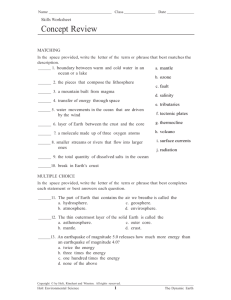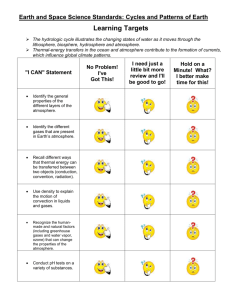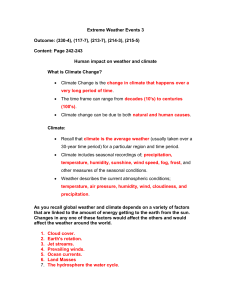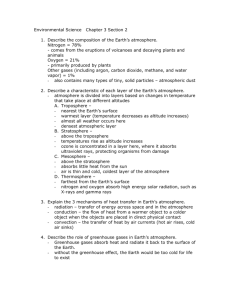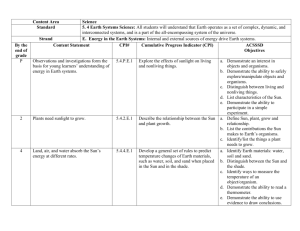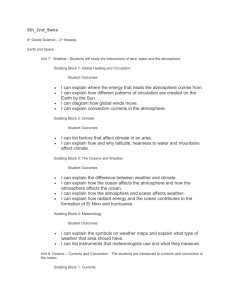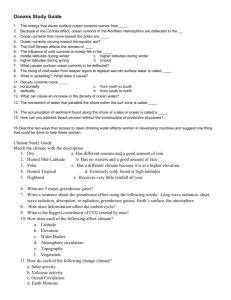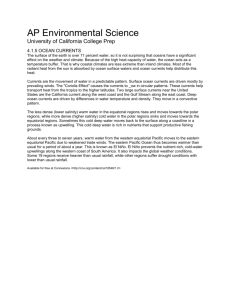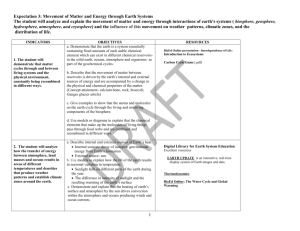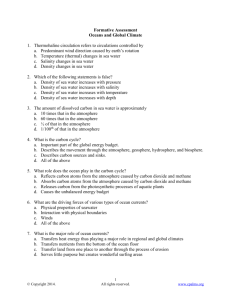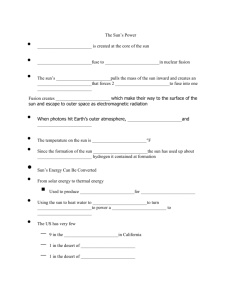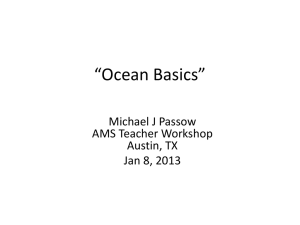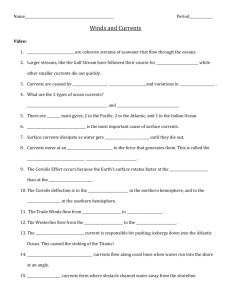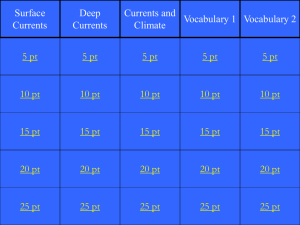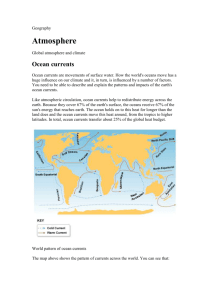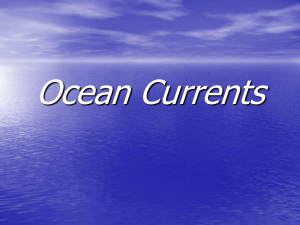Chapter 3 Questions
advertisement
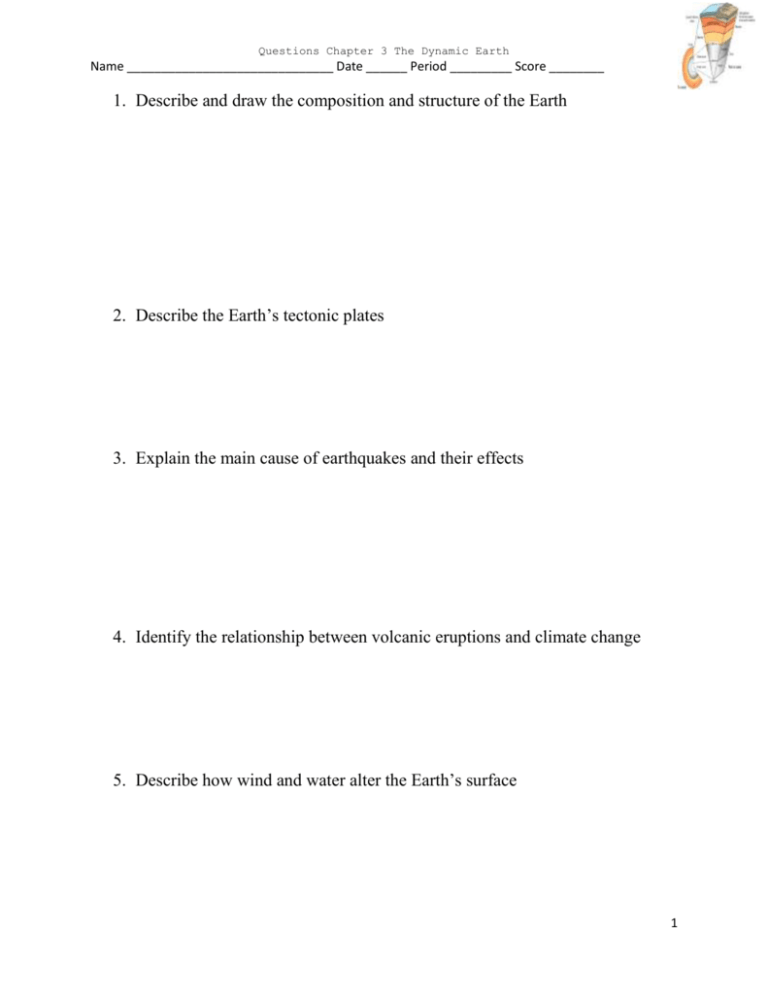
Questions Chapter 3 The Dynamic Earth Name ______________________________ Date ______ Period _________ Score ________ 1. Describe and draw the composition and structure of the Earth 2. Describe the Earth’s tectonic plates 3. Explain the main cause of earthquakes and their effects 4. Identify the relationship between volcanic eruptions and climate change 5. Describe how wind and water alter the Earth’s surface 1 Questions Chapter 3 The Dynamic Earth Name ______________________________ Date ______ Period _________ Score ________ 6. Describe the composition of the Earth’s atmosphere 7. Describe the layers of the Earth’s Atmosphere 8. Explain 3 mechanisms of heat transfer in Earth’s Atmosphere. 9. Explain the greenhouse effect. 10.Name 3 major process in the water cycle. 11.Describe the 2 types of ocean currents. 2 Questions Chapter 3 The Dynamic Earth Name ______________________________ Date ______ Period _________ Score ________ 12.Explain how the ocean regulates Earth’s temperature. 13.Discuss the factors that confine life to the biosphere. 14.Explain the difference between open and closed systems. Give examples. MATCHING: In the space provided, write the letter of the term or phrase that best matches the description. a. mantle e. tributaries i. surface currents b. ozone f. tectonic plates j. radiation c. fault g. thermocline d. salinity h. volcano ______ 1. boundary between warm and cold water in an ocean or a lake ______ 2. the pieces that compose the lithosphere ______ 3. a mountain built from magma ______ 4. transfer of energy through space ______ 5. water movements in the ocean that are driven by the wind ______ 6. layer of Earth between the crust and the core ______ 7. a molecule made up of three oxygen atoms ______ 8. smaller streams or rivers that flow into larger ones ______ 9. the total quantity of dissolved salts in the ocean ______10. break in Earth’s crust 3 Questions Chapter 3 The Dynamic Earth Name ______________________________ Date ______ Period _________ Score ________ MULTIPLE CHOICE: In the space provided, write the letter of the term or phrase that best completes each statement or best answers each question. ______11. The part of Earth that contains the air we breathe is called the a. hydrosphere. c. geosphere. b. atmosphere. d. envirosphere. ______12. The thin outermost layer of the solid Earth is called the a. asthenosphere. c. outer core. b. mantle. d. crust. ______13. An earthquake of magnitude 5.0 releases how much more energy than an earthquake of magnitude 4.0? a. twice the energy c. one hundred times the energy b. three times the energy d. none of the above ______14. Volcanoes occur at tectonic plate boundaries that are a. colliding. c. separating from one another. b. slipping past one another. d. Both (a) and (c) ______15. The removal and transport of surface material by wind and water is called a. seismicity. c. tectonics. b. erosion. d. vulcanism. ______16. The stratosphere is the atmospheric layer above the a. troposphere. b. ionosphere. c. mesosphere. d. thermosphere. ______ 17. Which of the following gases is an important greenhouse gas? a. hydrogen c. carbon dioxide b. nitrogen d. oxygen ______18. The most abundant gas in Earth’s atmosphere is a. oxygen. c. nitrogen. b. carbon dioxide. d. hydrogen. 4 Questions Chapter 3 The Dynamic Earth Name ______________________________ Date ______ Period _________ Score ________ ______19. The transfer of heat by air currents (or currents in a liquid) is called a. radiation. c. convection. b. conduction. d. condensation. ______20. The warmest temperature zone of the ocean is the a. thermocline. c. open ocean. b. deep zone. d. surface zone ______21. Stream-like movements of cold, dense water near the ocean floor are called a. surface currents. c. bottom currents. b. deep currents. d. mixing currents. ______22. One of the most important roles of the ocean is to a. add oxygen to the atmosphere. b. trap heat near Earth. c. regulate temperatures in Earth’s atmosphere. d. absorb ultraviolet radiation. ______23. The narrow layer of Earth where life-supporting conditions exist is called the a. crust. c. troposphere. b. surface zone. d. biosphere. ______24. With respect to matter, Earth is mostly a. an open system. c. an ecosystem. b. a closed system. d. a biosphere. ______25. The most important dissolved elements in ocean water are a. calcium and magnesium. b. calcium and potassium. c. calcium and sodium. d. sodium and chlorine. 5
